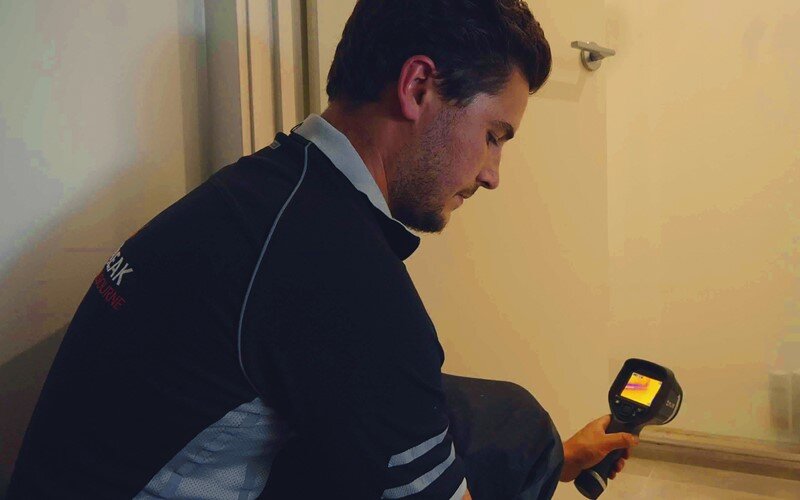6 Ways to Locate Concealed Water Leakages in Your House
6 Ways to Locate Concealed Water Leakages in Your House
Blog Article
Just about every person has got his or her own theory about Locating water leaks.

Early discovery of leaking water lines can mitigate a possible calamity. Some small water leaks might not be noticeable.
1. Check Out the Water Meter
Checking it is a proven means that aids you uncover leakages. If it moves, that indicates a fast-moving leak. This suggests you might have a slow-moving leak that can even be below ground.
2. Check Water Intake
Evaluate your water costs and also track your water intake. As the one paying it, you ought to see if there are any kind of discrepancies. If you spot sudden changes, in spite of your usage coinciding, it implies that you have leaks in your plumbing system. Bear in mind, your water costs need to drop under the very same variety on a monthly basis. A sudden spike in your expense suggests a fast-moving leak.
A stable rise every month, also with the same practices, shows you have a slow-moving leakage that's also gradually rising. Call a plumber to thoroughly examine your building, specifically if you feel a warm area on your flooring with piping underneath.
3. Do a Food Coloring Test
30% comes from bathrooms when it comes to water usage. Test to see if they are running appropriately. Decrease flecks of food color in the container and also wait 10 mins. If the shade in some way infiltrates your dish during that time without flushing, there's a leakage in between the storage tank as well as dish.
4. Asses Outside Lines
Don't fail to remember to check your outside water lines also. Examination faucets by attaching a garden pipe. Should water permeate out of the connection, you have a loose rubber gasket. Change this as well as ensure all links are tight. It will aid get it expertly checked out and kept each year if you've got a lawn sprinkler system. One tiny leak can squander lots of water and spike your water expense.
5. Check as well as Assess the Scenario
Home owners ought to make it a habit to examine under the sink counters and also even inside closets for any type of bad odor or mold and mildew growth. These two warnings suggest a leak so timely attention is needed. Doing regular examinations, even bi-annually, can save you from a major problem.
Extra importantly, if you recognize your house is already old, maintain a watchful eye on your heating systems, tubes, pipelines and so on. Look for stainings and also compromising as the majority of appliances as well as pipelines have a life span. They will likewise naturally wear away as a result of deterioration. If you believe leaking water lines in your plumbing system, don't await it to escalate. Call a professional plumber right now so you do not end up with a horrible mess in your home.
Early detection of dripping water lines can mitigate a potential calamity. Some little water leakages may not be visible. Checking it is a surefire means that assists you find leaks. One tiny leakage can waste tons of water and increase your water costs.
If you presume leaking water lines in your plumbing system, don't wait for it to escalate.
WARNING SIGNS OF WATER LEAKAGE BEHIND THE WALL
PERSISTENT MUSTY ODORS
As water slowly drips from a leaky pipe inside the wall, flooring and sheetrock stay damp and develop an odor similar to wet cardboard. It generates a musty smell that can help you find hidden leaks.
MOLD IN UNUSUAL AREAS
Mold usually grows in wet areas like kitchens, baths and laundry rooms. If you spot the stuff on walls or baseboards in other rooms of the house, it’s a good indicator of undetected water leaks.
STAINS THAT GROW
When mold thrives around a leaky pipe, it sometimes takes hold on the inside surface of the affected wall. A growing stain on otherwise clean sheetrock is often your sign of a hidden plumbing problem.
PEELING OR BUBBLING WALLPAPER / PAINT
This clue is easy to miss in rooms that don’t get much use. When you see wallpaper separating along seams or paint bubbling or flaking off the wall, blame sheetrock that stays wet because of an undetected leak.
BUCKLED CEILINGS AND STAINED FLOORS
If ceilings or floors in bathrooms, kitchens or laundry areas develop structural problems, don’t rule out constant damp inside the walls. Wet sheetrock can affect adjacent framing, flooring and ceilings.
https://www.servicemasterbyzaba.com/blog/how-to-detect-water-leakage-in-walls/

I am just very focused on Finding hidden leaks and I hope you appreciated the entire piece. Sharing is nice. One never knows, you could be helping someone out. Thanks for your time invested reading it.
Report this page